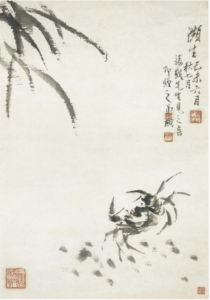Qi Baishi was an artist that transcended the turmoil of his country and was deeply connected to his Chinese roots. Qi Baishi did not start his career in art until he was 27, only liking to draw as a child, but was very poor. He wasn’t a masterful and skilled painter until he was in his sixties where he a very individualistic style. Some of his most famous artworks are his drawings of crabs and shrimp, mainly very simple but they have many more profound meanings. In his earliest artwork of a crab, it seems very simple, but each stroke has a specific sense to the painting. This Scuttling Crab painting was created around the time the May Fourth Movement and the country was facing many issues at the time. In the following years, there was death and famine, as well as warlord power. This simple painting wasn’t meant for only the rich, and those could understand, but many could appreciate its beauty. His shrimp paintings are very different yet so simple in comparison to other artworks at the time. Each shrimp is like a single Chinese character, formed by the same repetitive stroke, but at the same time, each one is just that much different to give it individuality. Mao Zedong named Qi Baishi the people’s artist in 1953, which is due to the paintings that were simple, but held beauty. Qi Baishi had a deep appreciation for nature, and that’s where almost all of his drawings and paintings come from.
This idea of simplicity was very important for China at the time and of course Qi Baishi, who enjoyed to paint, almost like a child. He didn’t want just those who could afford to understand the painting to see and appreciate it, but for all to recognize the beauty he was creating.


